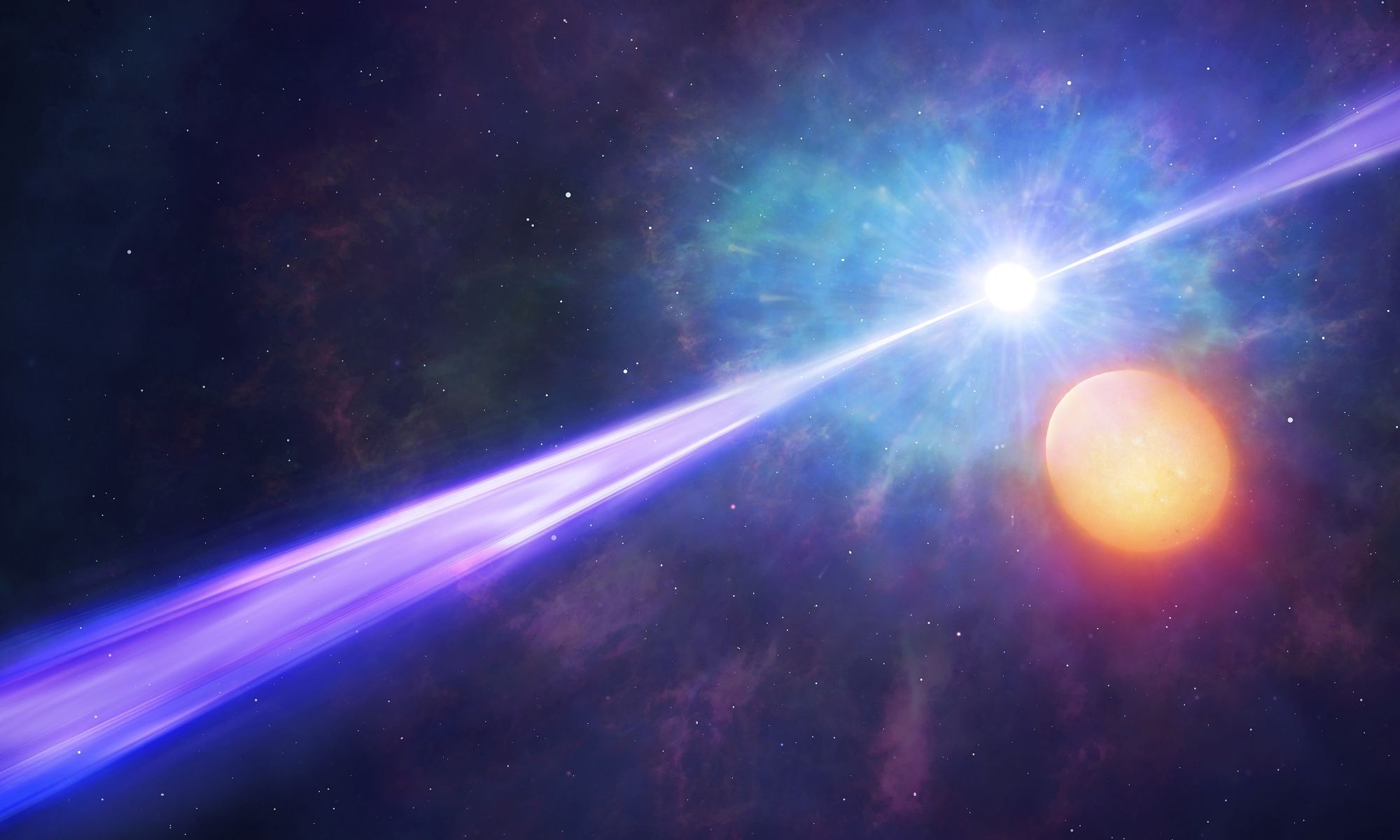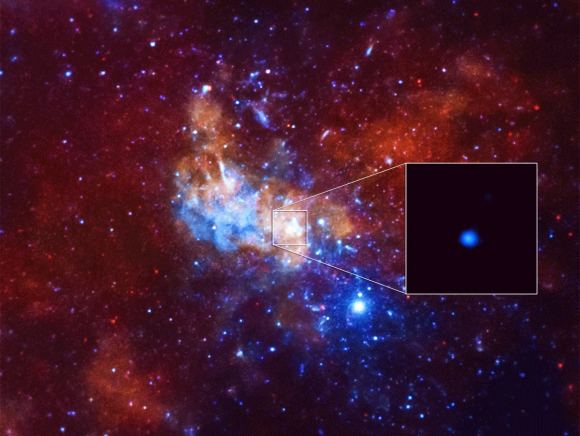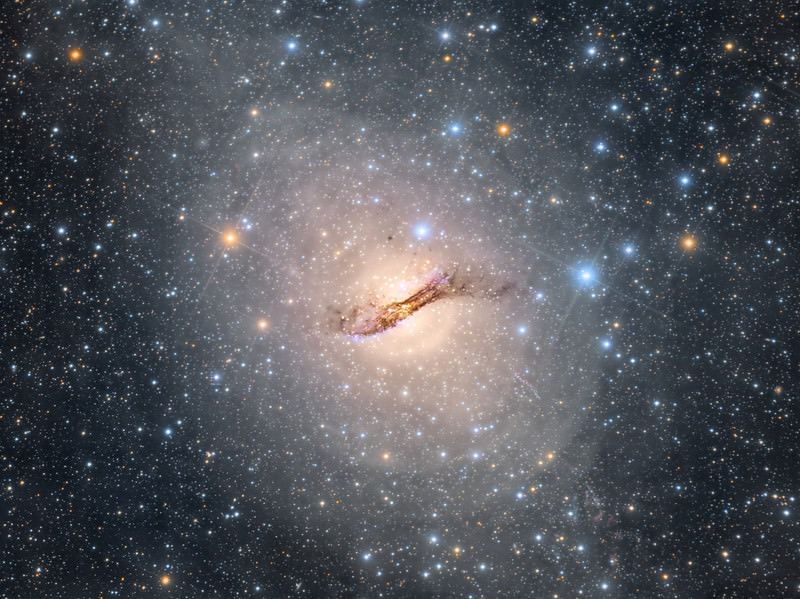We puny humans think we can accelerate particles? Look how proud we are of the Large Hadron Collider. But any particle accelerator we build will pale in comparison to Quasars, nature’s champion accelerators.
Those things are beasts.
Read more
We puny humans think we can accelerate particles? Look how proud we are of the Large Hadron Collider. But any particle accelerator we build will pale in comparison to Quasars, nature’s champion accelerators.
Those things are beasts.
Read more
The Chandra X-Ray Observatory has spotted a distant black hole shooting out jets of material, at close to the speed of light. No worries, this beast is about 10,000 light years away from us. It’s more of a spectacle than a danger.
But it’s a spectacle laden with scientific insights.
Continue reading “Black Hole Seen Blasting Out Jets at Close to the Speed of Light”
In the past few decades, astronomers have been able to look farther into the Universe (and also back in time), almost to the very beginnings of the Universe. In so doing, they’ve learned a great deal about some of the earliest galaxies in the Universe and their subsequent evolution. However, there are still some things that are still off-limits, like when galaxies with supermassive black holes (SMBHs) and massive jets first appeared.
According to recent studies from the International School for Advanced Studies (SISSA) and a team of astronomers from Japan and Taiwan provide new insight on how supermassive black holes began forming just 800 million years after the Big Bang, and relativistic jets less than 2 billion years after. These results are part of a growing case that shows how massive objects in our Universe formed sooner than we thought.
Continue reading “How were Supermassive Black Holes Already Forming and Releasing Powerful Jets Shortly After the Big Bang?”
Since 1958, the NASA Explorer Program has conducted low-cost missions that were deemed relevant to the goals of the Science Mission Directorate (SMD), particularly where the study of our Sun and the deeper cosmic mysteries are concerned. Recently, the Explorer Program selected four missions that they considered to be well-suited to these goals, two of which will be selected for launch in the coming years.
Consisting of two astrophysics Small Explorer (SMEX) and two Missions of Opportunity (MO) proposals, these missions are designed to study cosmic explosions and the debris they leave behind, as well as monitor how nearby stellar flares may affect the atmospheres of orbiting planets. After detailed evaluations, two of these missions will be selected next year and will take to space sometime in 2025.
Continue reading “NASA Chooses 4 New Astronomy Space Missions for Additional Study”
In 1967, NASA scientists noticed something they had never seen before coming from deep space. In what has come to be known as the “Vela Incident“, multiple satellites registered a Gamma-Ray Burst (GRB) that was so bright, it briefly outshined the entire galaxy. Given their awesome power and the short-lived nature, astronomers have been eager to determine how and why these bursts take place.
Decades of observation have led to the conclusion that these explosions occur when a massive star goes supernova, but astronomers were still unsure why it happened in some cases and not others. Thanks to new research by a team from the University of Warwick, it appears that the key to producing GRBs lies with binary star systems – i.e. a star needs a companion in order to produce the brightest explosion in the Universe.
Continue reading “It Takes Two Stars to Make a Gamma Ray Burst”
In August of 2017, the Laser Interferometer Gravitational-Wave Observatory (LIGO) detected waves that were believed to be caused by a neutron star merger. This “kilonova” event, known as GW170817, was the first astronomical event to be detected in both gravitational and electromagnetic waves – including visible light, gamma rays, X-rays, and radio waves.
In the months that followed the merger, orbiting and ground-based telescopes around the world have observed GW170817 to see what has resulted from it. According to a new study by an international team of astronomers, the merger produced a narrow jet of material that made its way into interstellar space at velocities approaching the speed of light.
Continue reading “Superfast Jet of Material Blasted Out From Last Year’s Neutron Star Merger”

Black holes have been an endless source of fascination ever since Einstein’s Theory of General Relativity predicted their existence. In the past 100 years, the study of black holes has advanced considerably, but the awe and mystery of these objects remains. For instance, scientists have noted that in some cases, black holes have massive jets of charged particles emanating from them that extend for millions of light years.
These “relativistic jets” – so-named because they propel charged particles at a fraction of the speed of light – have puzzled astronomers for years. But thanks to a recent study conducted by an international team of researchers, new insight has been gained into these jets. Consistent with General Relativity, the researchers showed that these jets gradually precess (i.e. change direction) as a result of space-time being dragged into the rotation of the black hole.
Their study, titled “Formation of Precessing Jets by Tilted Black Hole Discs in 3D General Relativistic MHD Simulations“, recently appeared in the Monthly Notices of the Royal Astronomical Society. The team consisted of members from the at Northwestern University.
For the sake of their study, the team conducted simulations using the Blue Waters supercomputer at the University of Illinois. The simulations they conducted were the first ever to model the behavior of relativistic jets coming from Supermassive Black Holes (SMBHs). With close to a billion computational cells, it was also the highest-resolution simulation of an accreting black hole ever achieved.
As Alexander Tchekhovskoy, an assistant professor of physics and astronomy at Northwestern’s Weinberg College of Arts and Sciences, explained in a recent Northwestern Now press release:
“Understanding how rotating black holes drag the space-time around them and how this process affects what we see through the telescopes remains a crucial, difficult-to-crack puzzle. Fortunately, the breakthroughs in code development and leaps in supercomputer architecture are bringing us ever closer to finding the answers.”
Much like all Supermassive Black Holes, rapidly spinning SMBHs regularly engulf (aka. accrete) matter. However, rapidly spinning black holes are also known for the way they emit energy in the form of relativistic jets. The matter that feeds these black holes forms a rotating disk around them – aka. an accretion disk – which is characterized by hot, energized gas and magnetic field lines.
It is the presence of these field lines that allows black holes to propel energy in the form of these jets. Because these jets are so large, they are easier to study than the black holes themselves. In so doing, astronomers are able to understand how quickly the direction of these jets change, which reveals things about the rotation of the black holes themselves – such as the orientation and size of their rotating disks.
Advanced computer simulations are necessary when it comes to the study of black holes, largely because they are not observable in visible light and are typically very far away. For instance, the closest SMBH to Earth is Sagittarius A*, which is located about 26,000 light-years away at the center of our galaxy. As such, simulations are the only way to determine how a highly complex system like a black hole operates.
In previous simulations, scientists operated under the assumption that black hole disks were aligned. However, most SMBHs have been found to have tilted disks – i.e. the disks rotate around a separate axis than the black hole itself. This study was therefore seminal in that it showed how disks can change direction relative to their black hole, leading to precessing jets that periodically change their direction.
This was previously unknown because of the incredibly amount of computing power that is needed to construct 3-D simulations of the region surrounding a rapidly spinning black hole. With the support of a National Science Foundation (NSF) grant, the team was able to achieve this by using the Blue Waters, one of the largest supercomputers in the world.

With this supercomputer at their disposal, the team was able to construct the first black hole simulation code, which they accelerated using graphical processing units (GPUs). Thanks to this combination, the team was able to carry out simulations that had the highest level of resolution ever achieved – i.e. close to a billion computational cells. As Tchekhovskoy explained:
“The high resolution allowed us, for the first time, to ensure that small-scale turbulent disk motions are accurately captured in our models. To our surprise, these motions turned out to be so strong that they caused the disk to fatten up and the disk precession to stop. This suggests that precession can come about in bursts.”
The precession of relativistic jets could explain why light fluctuations have been observed coming from around black holes in the past – which are known as quasi-periodic oscillations (QPOs). These beams, which were first discovered by Michiel van der Klis (one of the co-authors on the study), operate in much the same way as a quasar’s beams, which appear to have a strobing effect.
This study is one of many that is being conducting on rotating black holes around the world, the purpose of which is to gain a better understanding about recent discoveries like gravitational waves, which are caused by the merger of black holes. These studies are also being applied to observations from the Event Horizon Telescope, which captured the first images of Sagittarius A*’s shadow. What they will reveal is sure to excite and amaze, and potentially deepen the mystery of black holes.
In the past century, the study of black holes has advanced considerably – from the purely theoretical, to indirect studies of the effects they have on surrounding matter, to the study of gravitational waves themselves. Perhaps one day, we might actually be able to study them directly or (if it’s not too much to hope for) peer directly inside them!
Further Reading: Northwestern Now, MNRAS

Sometimes, you just have to say “Wow!”
The view you’re looking at above is of Centaurus A (NGC 5128), a galaxy about 10-16 million light years distant in the southern hemisphere sky. It’s a favorite of astrophotographers and professional observatories alike.
But what makes this image so special is that it was taken by an amateur astrophotographer.
To construct this amazing image, New Zealand-based astrophotographer Rolf Wahl Olsen exposed the field of view for 120 hours over 43 nights spanning February to May of this year.
Rolf recently shared his motivation to construct this image;
“Over the past few months I have been on a mission to achieve a long time dream of mine: taking a deep sky image with more than 100 hours of exposure.”
Rolf also noted that the stars in the frame are visible down to magnitude +25.45, which “appears to go deeper than the recent ESO release” and believes that it may well be “the deepest view ever obtained of Centaurus A,” As well as “the deepest image ever taken with amateur equipment.”
Not only is the beauty and splendor of the galaxy revealed in this stunning mosaic, but you can see the variations in the populations of stars in the massive regions undergoing an outburst of star formation.
One can also see the numerous globular clusters flocking around the galaxy, as well as the optical counterparts to the radio lobes and the faint trace of the relativistic jets. The extended halo of the outer shell of stars is also visible, along with numerous foreground stars visible in the star rich region of Centaurus.
Finally, we see the dusty lane bisecting the core of this massive galaxy as seen from our Earthly vantage point.
To our knowledge, many of these features have never been captured visually by backyard observers before, much less imaged. Congrats to Rolf Wahl Olsen on a spectacular capture and sharing his view of the universe with us!
Read more on the Centaurus A deep field on Google+.
-Check out the comparison images of the Centaurus A deep field showing the relativistic jet (!) background galaxies and clusters.
-Explore more of Rolf’s outstanding work at his website.